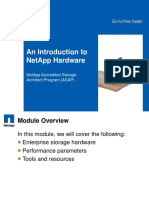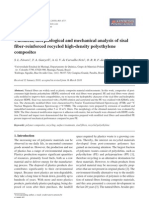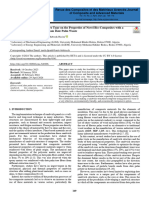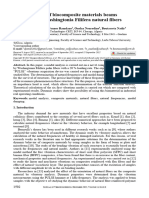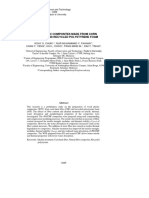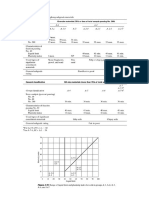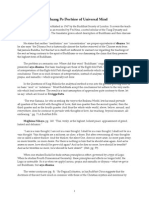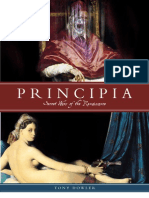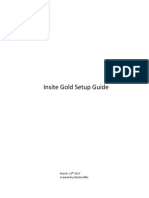Comparative Study of Thermal Insulation Boards From Leaf and Bark Fibres of Camel'S Foot (L.)
Comparative Study of Thermal Insulation Boards From Leaf and Bark Fibres of Camel'S Foot (L.)
Uploaded by
SheenaCopyright:
Available Formats
Comparative Study of Thermal Insulation Boards From Leaf and Bark Fibres of Camel'S Foot (L.)
Comparative Study of Thermal Insulation Boards From Leaf and Bark Fibres of Camel'S Foot (L.)
Uploaded by
SheenaOriginal Title
Copyright
Available Formats
Share this document
Did you find this document useful?
Is this content inappropriate?
Copyright:
Available Formats
Comparative Study of Thermal Insulation Boards From Leaf and Bark Fibres of Camel'S Foot (L.)
Comparative Study of Thermal Insulation Boards From Leaf and Bark Fibres of Camel'S Foot (L.)
Uploaded by
SheenaCopyright:
Available Formats
Nigerian Journal of Technology (NIJOTECH)
Vol. 37, No. 1, January 2018, pp. 108 – 114
Copyright© Faculty of Engineering, University of Nigeria, Nsukka,
Print ISSN: 0331-8443, Electronic ISSN: 2467-8821
www.nijotech.com
http://dx.doi.org/10.4314/njt.v37i1.14
COMPARATIVE STUDY OF THERMAL INSULATION BOARDS FROM LEAF
AND BARK FIBRES OF CAMEL’S FOOT (PILIOSTIGMA THONNINGII L.)
M. Abubakar1,*, A. Raji2 and M. A. Hassan3
1 NATIONAL SPACE RESEARCH AND DEVELOPMENT AGENCY, PYKASA JUNCTION, AIRPORT ROAD, ABUJA-NIGERIA
2, 3 DEPT. OF MECHANICAL ENGR., MODIBBO ADAMA UNIVERSITY OF TECHNOLOGY, YOLA, ADAMAWA STATE. NIGERIA
Email addresses: 1 musaabubakar2000@yahoo.com, 2 rajifuty@yahoo.com, 3 mahassan@mautech.edu.ng
ABSTRACT
Plants and agricultural wastes with high degrees of fibrous content in form of lignocellulose compounds have been
identified as main ingredient in composites, making them suitable for manufacturing of insulation boards and panels.
Thus, several researches have succeeded in using these plants and agro waste fibres in developing renewable and
environmentally friendly thermal insulation products. The aim of this study was to compare the performance of
insulation boards made from leave and bark fibres of Piliostigma thonningii L.in terms of density, water absorption,
apparent thermal conductivity, specific heat and thermal diffusivity. The leave and the bark fibres were prepared in
form of squared boards of 200 mm x 200 mm and thickness of 20 mm using natural rubber latex as a binder. The fibre
to binder ratio was varied with a composition of 1:1, 1:2, 1:3 and 1:4. The LFB recorded densities between 528.6
kg/m3 and 538.4 kg/m3 while in the BFB the densities are between 558.3 kg/m3 and 711.8 kg/m3at various
compositions. The Percentage water absorption for the LFB is between 36.51% and 12.03% while the BFB is between
25.02% and 13.23%. Similarly, the apparent thermal conductivity values for LFB are between 0.032096 W/mK and
0.040855 W/mK while that of the BFB are between 0.039439 W/mK and 0.043406 W/mK. The specific heat values of
the LFB are between 2901.88 J/kg.K and 3656.48 J/kg.K and that of the BFB are between 2044.46 J/kg.K and 2512.61
J/kg.K while the thermal diffusivity is between 2.05E-8 m2/s and 8.07E-9 m2/s for the LFB and 1.57E-8 m2/s to 2.68E-
8 m2/s for BFB. The boards recorded thermal properties that are comparable to those of the commercially available
products with LFB performing consistently better than the BFB.
Key words: Thermal Insulation, Leave fibres, Bark fibres, apparent thermal conductivity, Lignocellulose compounds,
Fibrous content.
1. INTRODUCTION polyestyrene have some negative effects on human
It has become prevalent to use thermal insulation health and body and cause environmental pollution due
materials to sustain confortable temperatures in living to non-decomposition after their useful life [4].
environment and to reduce the cost of heating and According to Berge and Johansson [5], thermal
cooling as a result of heat loss or gain in industrial insulation materials such as polyurethane (PUR) foam
processes [1, 2]. Due to the rising energy demand and contains ozone depleting chlorofluorocarbons (CFC-
consumption, fluctuating prices of fossil fuels (crude 11) which are of great environmental concern. For
oil) and its resultant effect of global warming, energy these reasons, there is an urgent need for a more
conservation through the use of thermal insulation is environmentally friendly biodegradable low
regarded as an effective and efficient method [3, 4]. temperature thermal insulation material to replace the
Thus thermal insulation materials play an important commercially available ones.
role in achieving high energy efficiency resulting in Several authors have proposed different plants and
decrease in the cost of cooling and heating as well as agricultural wastes for making products such as
decrease in environmental pollution. However, the particles boards, hard boards and fibre boards focusing
commonly used materials for low temperature majorly on their thermal insulation [6]. These studies
application such as polyurethane, polyisocynurate and revealed the potentials of the natural biodegradable
* Corresponding author, tel: +234 – 805 – 953 – 5686
COMPARATIVE STUDY OF THERMAL INSULATION BOARDS FROM LEAF AND BARK FIBRES OF CAMEL’S FOOT, M. Abubakar, et al
fibrous materials for production of thermal insulation hours to soften the fibres. The fibres were thoroughly
with numerous benefits to the health and environment. rinsed in a fresh tap water and air dried. The dried
Panyakaew and Fotios [7] opined that the use of samples were ground into small sizes using a
renewable fibrous materials especially from commercial grinder and then used for the preparation
agricultural by-products for thermal insulation will in of the particles board. Two different sets of samples,
addition generate economic development for farming one from the bark fibres and the other from the leaves
and rural populace. Some of the materials studied in were prepared separately as described above and
this context include; rice husk [8], oil-palm fibres [9], stored in nylon. A rectangular wooden mould of size
papyrus fibres [4], pineapple leaves [2], coconut husk 200 mm by 200 mm was constructed with a thickness
[8, 10, 11], straw [12], corn cob [6] to mention but few. 20 mm. A required quantity of the fibre and the binder
The plant studied in this work is the Camel’s foot was charged into a mixer rotating at 120rpm and
(Piliostigma thonningii L.) which has been used continuously mixed for 10 minutes until the particles
traditionally in form of mats and loose-fill insulation were thoroughly impregnated with the resin and the
and as thatch by Fulani herders in the northern part of mixture was then poured into the mould. A force of
Nigeria purposely to insulate their huts from hot and 0.25 kN was applied to ensure even settling of the
cold weathers. These facts inspired us to study the product and was allowed to cure under the sun for five
fibres in form of particle boards to ascertain or (5) days. Four (4) types of boards were produced from
otherwise the insulation ability of the fibres. In each sample with particles to binder ratios of 1:1, 1:2,
preparation of the boards, natural rubber latex was 1:3 and 1:4. After forming, the boards were then cut
chosen as a binder which is of great interest from into various test samples.
environmental perspective since most of the
conventional binders such as formaldehyde and urea 2.3 Tests
formaldehyde are harmful to human health due to To determine the suitability of the particle boards for
emission of toxic substances and causes environmental insulation, the thermal properties are of prime
pollution [2]. importance. But other physical and thermo physical
Thus, the aim of the research was to develop thermal properties are also significant. Hence, the following
insulation boards from the leaves and bark fibres of tests were conducted on the fibre boards.
Camel’s foot (Piliostigma Thonningii L.), investigate the
physical properties viz; density and water absorption 2.3.1 Microscopic Analysis
and thermal properties viz; thermal conductivity, A specimen of about 3 cm diameter was cut from each
specific heat and thermal diffusivity. The performance of the boards for surface preparation. The surface of
of the boards from the two different materials was then interest on the cut samples were ground with abrasive
compared. In addition, micro structure analysis of the paper starting with coarse grit and finishing with a fine
boards was carried out using scanning electron grit. The surface was then thoroughly cleaned and
microscope (SEM). polished to reveal the surface contrast. The
microstructure analysis of the prepared board’s
2. MATERIALS AND METHOD samples was performed on the polished surfaces by
2.1 Materials Scanning Electron Microscopy (SEM).
The major raw materials for this work are the bark
fibres and the leave fibres of Camel’s foot ( Piliostigma 2.3.2 Density
thonningii L.) which were collected from Girei Local The densities of the boards were determined in
Government Area of Adamawa State, Nigeria. Other accordance with the American Society for Testing and
materials include sodium hydroxide (NaOH), distilled Materials (ASTM) C303-02 (Standard test method for
water and Pre-treated natural rubber latex all of dimensions and density of preformed block and board
analytical grade obtained from Northern Scientific type thermal insulation) [13]. From each of the
Chemicals shop in Yola, Nigeria. produced boards, four (4) specimens of 60 mm x 60
mm were cut. The thickness, length and the width were
2.2 Materials Preparation and Moulding measured in three (3) different locations, with the
The major raw materials, which are the bark fibre and thickness measured generally near the four corners of
the leave fibres of Camel’s foot (Piliostigma thonningii each specimen and the average of each was determined
L.), were mercerized using 5%w/v sodium hydroxide and recorded. The volume of each specimen was then
(NaOH) solution at room temperature of 340C for 24 calculated.
Nigerian Journal of Technology, Vol. 37, No. 1, January 2018 109
COMPARATIVE STUDY OF THERMAL INSULATION BOARDS FROM LEAF AND BARK FIBRES OF CAMEL’S FOOT, M. Abubakar, et al
Each specimen was weighed using a digital weighing For each set of readings, the derived results were
balance and the mass recorded. The density of each tabulated under the following headings: heat flow Q =
specimen was then calculated using equation (1): IV; cross sectional area /4; temperature of hot
mass k face (Thot) and cold face (Tcold) which were determined
[ ⁄ ] (
using equations 2 and 3.
(
here T (
2.3.3 Water Absorption
The water absorption test was conducted according to (
T T (
ASTM D1037 (water absorption test method A) [13].
The specimens used in the determination of the density The temperature difference across the specimen was
were used since their masses and volumes were determined from equation 4
recorded. The water absorption was expressed as the T T T (
percentage increase in volume based on the volume The thermal conductivity (k) of the specimen was
before submersion. The specific gravity of the water calculated using Fourier rate equation given by
was assumed to be 1.0 for this purpose. equation 5.
Δx
( mK (
2.3.4 Apparent Thermal Conductivity
2.3.5 Specific Heat
The apparent thermal conductivity of the boards was
The specific heat test was conducted according to
determined in accordance with ASTM C518-02
ASTM C351-92b (Standard test method for mean
(Standard Test Method for Steady –State Thermal
specific heat of thermal insulation) (ASTM, 2004).
Transmission Properties by Means of the Heat Flow
Meter Apparatus) [13]. The equipment used for the test
2.3.6 Thermal Diffusivity
was Armfield HT10XC Heat Transfer Service Unit and
The thermal diffusivity of the material was calculated
HT11C Computer Compatible Linear Heat Conduction
using equation (6) [14] as shown:
Accessory. From each of the boards, four (4) specimens
were cut in form of a disc with a diameter (d) of 25±1 (m s (
mm and the thickness (Δx was measured and
Where; k, and are the apparent thermal
recorded. A specimen was clamped tightly in between
conductivity, density and the specific heat of the
two faces of heated and cooled brass sections, the
material respectively as obtained from the experiments
heater voltage (V) was set to 10 volts and the heater
on thermal conductivity, density and specific heat.
current (I) was read from the console and recorded.
After HT11C was stabilised, the temperatures T1, T2, T3,
3. RESULTS AND DISCUSSION
T6, T7 and T8 were also read and recorded from the
3.1 SEM Images
console display. Where T1, T2 and T3 are the
Plates 1 (a) – (d) show boards from the leave fibres
thermocouples connected to the heating section of the
with particles to binder ratio of 1:1, 1:2, 1:3 and 1:4,
instrument and T6, T7 and T8 are those connected to the
respectively.
cold section of the instrument.
a b c d
e f g h
Plate 1: SEM Micrograph of the Piliostigma thonningii L. fibre boards (400X)
Nigerian Journal of Technology, Vol. 37, No. 1, January 2018 110
COMPARATIVE STUDY OF THERMAL INSULATION BOARDS FROM LEAF AND BARK FIBRES OF CAMEL’S FOOT, M. Abubakar, et al
composition increases the percentage of water
absorption [15]. The result of T-test comparing the
mean percentage water absorption from the leave fibre
(LBF) and the bark fibre boards (BFB) shows that the
boards differ significantly from each other with the
bark fibre boards recording lower percentage water
absorption compared to the boards from the leave fibre
boards.
It can be observed that as the binder part in the ratio
Figure 1: Comparison of Densities of LFB and BFB at increases the particles concentration decreases. From
different compositions the SEM fibre histogram, it was observed that the
diameters of the fibres for the leave fibre boards range
between .0 to 8.9 μm while that of the bark fibre
boards ran e between . 7 and 0. μm. The ore
size histogram of the SEM also reveals the presence of
air spaces and their distribution within the surfaces of
the boards with the pore sizes ranging between 0.64
and 7 0 μm2 in the leave fibre boards while the pore
sizes in the bark fibre boards range between 0.64 and
8 μm2.
Figure 2: Percentage water absorption of LFB and BFB 3.2 Density
at different compositions Figure 1 presents the average densities of the boards
from the leaves fibres (LFB) and bark fibres (BFB). For
While (e) – (h) are boards from the bark fibres with the the leave fibre boards, the figure reveals that the
fibre to binder ratio of 1:1, 1:2, 1:3 and 1:4, densities of the boards at fibre to binder ratio of 1:1,
respectively. The SEM micrograph revealed that the 1:2, 1:3 and 1:4 are 528.6 kg/m3, 529.3 kg/m3, 534.4
boards consist of particles which are bonded strongly kg/m3 and 538.4kg/m3 respectively. For the bark fibre
with each other and with the binder boards at fibre to binder ratio of 1:1, 1:2, 1:3 and 1:4
are 558.3 kg/m3, 673.3 kg/m3, 691.4 kg/m3 and 711.8
3.3 Water Absorption kg/m3 respectively. The result of t-test comparing the
The results of average water absorption properties of mean densities of the boards from LFB and BFB shows
the boards from leave fibre (LFB) and bark fibre (BFB) that there is significant difference in the average
at fibre to binder ratio of 1:1, 1:2, 1:3 and 1:4 are densities of the boards at 5% significant level. From the
presented in Figure 2. The results indicate that for BFB results, it can be seen that the leaves fibre boards (LBF)
the percentage water absorption at fibre to binder ratio recorded correspondingly lower densities compared to
of 1:1, 1:2, 1:3 and 1:4 are 25.02%, 17.72%, 14.43%, the boards from the bark fibres (BFB). The figure
and 13.23% respectively. On the other hand, the results shows that for both sam les the board’s densities
show that the LFB at fibre to binder ratio of 1:1, 1:2, 1:3 increase as the part of the binder in the composition
and 1:4 have average water absorption of 36.51%, increases. This may be as a result of more binder
23.88%, 15.03%, and 12.03% respectively. available to flow into the air pores between the fibres
From the figure, it can be seen that the percentage on the surfaces of the board, in addition to the fact that
water absorption decreases as the fibre to binder ratio lignocellulose fibres have lower densities compared to
varies from 1:1 to 1:4. Thus, it can be deduced from polymeric materials; therefore, increasing the binder in
figures 1 and 2 that the percentage water absorption is the composition will reflect increase in density which is
inversely proportional to the density. This is because in agreement with the studies of Tangjuank and Kumfu
the lower density boards have higher voids and pores [4].
as a result absorbed higher moisture. In addition,
natural fibres derived from lignocellulose are
hydrophilic in nature which contain strongly polarized
group, thus, increasing the quantity of the fibre in a
Nigerian Journal of Technology, Vol. 37, No. 1, January 2018 111
COMPARATIVE STUDY OF THERMAL INSULATION BOARDS FROM LEAF AND BARK FIBRES OF CAMEL’S FOOT, M. Abubakar, et al
followed the characteristics hooked-shape graph
associated with loose-fill fibrous thermal insulation.
That is, as the density increases from minimum
possible value, the apparent thermal conductivity
decreases to a minimum and then increases as reported
by some researchers [16, 9, 5, and 17]. For the LFB the
lowest apparent thermal conductivity recorded at
density of 528 kg/m3 (1:1) while the highest apparent
thermal conductivity value occurs at density of 534
kg/m3 corresponding to 1:3 compositions. Similarly,
Figure 3: Comparison of Thermal Conductivity of LFB the BFB recorded the lowest apparent thermal
and BFB at different composition conductivity value at density of 691 kg/m3 (1:3) and
highest value at 558 kg/m3 density corresponding to
1:1 composition.
3.5 Specific Heat
Figure 4 presents the results of specific heat for both
leave and bark fibre boards at different fibre to binder
ratios. For LFB, the results show that the boards have
specific heat values of 2901.88 J/kg.K to 3656.48 J/kg.K
as the composition of fibre to binder ratio increases
from 1:1 to 1:4. While for the BFB, the results indicate
that the specific heat values are between 2044.46
J/kg.K and 2512.61 J/kg.K as the fibre to binder ratio is
Figure 4: Specific heat values for LFB and BFB at varied from 1:1 to 1:4. The result of t-test comparing
different compositions the relationship between the LFB and the BFB shows
that there is significant difference in the mean specific
heat of the boards. From the figure, it can be observed
that the leaves fibre boards recorded higher specific
heat values as compared to the bark fibre boards for all
compositions of the fibre to binder ratio.
3.6 Thermal Diffusivity
Figure 5 shows the thermal diffusivity values for LFB
and BFB at fibre to binder ratio of 1:1, 1:2, 1:3 and 1:4.
Figure 5: Thermal diffusivity values for LFB and BFB at For LFB, the thermal diffusivity values are between
different composition 2.03E-8m2/s and 8.07E-9m2/s while for BFB, the
thermal diffusivity values are between 1.57 E-8m2/s
3.4 Apparent Thermal Conductivity and 2.68E-8m2/s. The results of t-test comparing the
Figure 3 compares the apparent thermal conductivities two samples show that there is significant difference in
of the leave fibre boards (LFB) and that of the bark the mean value of the thermal diffusivity. From the
fibre boards (BFB) at different compositions. For the figure, it can be observed that the thermal diffusivity
LFB, the apparent thermal conductivity values at 1:1, decreases as portion of binder in the fibre to binder
1:2, 1:3 and 1:4 are 0.032096W/mK, 0.039928W/mK, ratio increases. This signifies that the thermal
0.040855W/mK and 0.036385W/mK respectively. For diffusivity is inversely proportional to the density.
the BFB, the apparent thermal conductivities at 1:1, 1:2,
1:3 and 1:4 are 0.043406W/mK, 0.040951W/mK, 3.7 Comparison of Density and Thermal Conductivity of
0.039439W/mK and 0.041488W/mK respectively. the Developed Boards with Other Insulating Materials
The result of t-test comparing the mean apparent Table 1 compares the measured apparent thermal
thermal conductivities of the boards from LFB and BFB conductivity and density of the developed boards with
shows that there is significant difference in the mean that of the standard products and published data on
thermal conductivity values of the boards. The result biodegradable thermal insulation.
Nigerian Journal of Technology, Vol. 37, No. 1, January 2018 112
COMPARATIVE STUDY OF THERMAL INSULATION BOARDS FROM LEAF AND BARK FIBRES OF CAMEL’S FOOT, M. Abubakar, et al
Table 1: Comparison of Density and Thermal Conductivity of the Prepared Boards with Other Insulating Material
Insulation material Thermal conductivity
Density (kg/m3) Source
(W/mK)
Piliostigma thonningii leaves fibre boards (LFB) 528-538 0.0321-0.0409 Present study
Piliostigma thonningii Bark fibre boards(BFB)s 558-711 0.0394-0.0434 Present study
Cork boards 100-220 0.045-0.08 [18]
Mineral wool 20-200 0.035-0.045 [18]
Polyurethane 30-100 0.017-0.024 [18]
wood fibre boards 30-270 0.04-0.09 [18]
Extruded Polystyrene (XPS) 25-45 0.028-0.032 [18]
Expanded Polystyrene (EPS) 15-30 0.035-0.04 [18]
Vacuum Insulation panels (VIP) 150-300 0.002-0.008 [18]
Pineapple leaves 178-232 0.039-0.043 [2]
Oil Palm fibre 797 0.0555 [10]
Coconut husk 250-350 0.046-0.068 [7]
Bagasse 250- 350 0. 049-0.055 [7]
Corn cob 334 0.101 [6]
Straw 76.6 0.040-0.085 [12]
Papyrus fibre 232-266 0.0296-0.0304 [4]
Cotton stalk fibre 150-450 0.0585-0.0815 [19]
Narrowed leave cattail fibre 200-400 0.0438-0.0606 [20]
From the table, it can be observed that the developed www.cedengineering.com/.../
boards recorded higher densities compared to Overview%20of%20Insulation%20Materials,
synthetic product such as polyurethane, extruded and 2010.
expanded polystyrene, but can be compared favourably [2] Tangjuank, S. Thermal Insulation and Physical
with the boards from agro fibres such as oil palm, Properties of Particle boards from Pineapple
cotton stalk and narrowed leave cattail fibre boards. Leaves. International Journal of Physical Sciences,
Similarly, in terms of thermal conductivity, the 6 (19), 4528-4532. 2011.
developed boards can be compared favourably with [3] Bozsaky, D. The historical development of
most of the commercial products except polyurethane thermal insulation materials. Periodica
and vacuum insulation panels which have lower polytechnica, 41 (2), 49-56. Retrieved March 18,
2013, from: http://www.pp.bme.hu/ar 2010.
thermal conductivities.
[4] Tangjuank, S. and Kumfu, S. Particle boards from
4. CONCLUSION Papyrus Fiber as Thermal Insulation. Journal of
The research work revealed that the leave fibre boards Applied Sciences, 11; 2640-2645. DOI:
10.3923/jas.2011 Available at:
LBF of Piliostigma thonningii L. has larger voids
http://scialert.net/abstract/?doi=jas.2011.2640.
compared to the bark fibre boards BFB resulting in 2645 2011.
their lower densities and lower thermal conductivity. It
[5] Ber e A. and Johansson P. “Literature Review on
also indicates that the LFB has higher specific heat
High Performance Thermal Insulation, Report in
values and lower thermal diffusivity compared to the buildin hysics”, Chalmers University of
BFB. On the other hand, the BFB perform better than Technology, Gothenburg, Sweden. Retrieved May
the LFB in terms of water absorption properties. Thus, 12, rom:
it can be concluded that the boards from the leave fibre www.publications.lib.chalmers.se/records/fulltex
have better physical and thermal properties viz; t/local_159807.pdf, 2013.
density, thermal conductivity, specific heat and thermal [6] Paiva, A., Pereira, S., Ana Sá, A., Cruz, D., Varum, H.
diffusivity when compared with the boards from the and Pinto, J. A contribution to the Thermal
bark fibres under the same conditions. Insulation Performance Characterization of Corn
Cob Particleboards. Journal of Energy and
Buildings 45, 274–279. Available at
5 REFERENCES http://www.elsevier.com/copyright
doi:10.1016/j.enbuild.2011.11.019, 2012.
[1] Bhatia, A. Overview of Insulation Materials.
Continuing Education and Development Inc. New [7] Panyakaew, S. and Fotios, S. New thermal
York. Retrieved April 12, 2013, from: insulation boards made from coconut husk and
Nigerian Journal of Technology, Vol. 37, No. 1, January 2018 113
COMPARATIVE STUDY OF THERMAL INSULATION BOARDS FROM LEAF AND BARK FIBRES OF CAMEL’S FOOT, M. Abubakar, et al
bagasse, Energy and Buildings, 43 (7), pp. 1732- [15] Rakesh, K., Sangeeta, O. and Aparna, S. Chemical
1739, 2011 Modifications of Natural Fibre for Composite
Materials. Pelagia Research Library, Der Chemica
[8] Panyakaew, S. and Fotios, S. Agricultural waste
Sinica, 2(4), 219-228, 2011.
materials as thermal insulation in dwellings in
Thailand: Preliminary Results. 25th Conference on [16] Manohar, K., Ramlakhan, D., Kochhar, G. and
Passive and low energy Architecture. Dublin, 22nd Haldar, S. Biodegradable Fibrous Thermal
to 24th October, 2008. Insulation. Journal of Brazilian Society of
Mechanical Science and Engineering (28), 45-47,
[9] Manohar, K. Experimental investigation of
2006.
Building thermal insulation from Agricultural by-
products. British Journal of Applied Sciences and [17] Kochhar, G. S. and Manohar, K. Effect of Moisture
Technology, 2 (3), 227-239, 2012. on Thermal Conductivity of Fibrous Biological
Insulating Materials. Retrieved March 12, 2014
[10] Manohar, K. Renewable Building Thermal
from:
Insulation –Oil Palm Fiber. International Journal
www.ornl.gov/sci/buildings/2012/.../004_Kochh
of Engineering and Technology, 2(3), 475-479,
ar.pdf, 2012.
2012.
[18] Margit, P., Roland, G., Martins, H. S. & Alexander,
[11] Manohar, K. Biodegradable Thermal Insulation for
R. Insulating Materials; Principle, Materials,
Ice-coolers. International Journal of Modern
Application. First Edition, electronic version,
Engineering Research, 1 (2), 559-563. 2013.
2008.
[12] Marian, P. Investigations Regarding the Thermal
[19] Agham, R. D. State-of-the- Art Insulation
Conductivity of Straw. Buletinul Institutului
Materials: A review. International Journal of
Politehnic Din Iaşi LVI (LX), 3:6-15, 2010.
Engineering and Innovative Technology (IJEIT);
[13] American Society for Testing and Materials 2(6), 97-102, 2012.
(ASTM) Standard ASTM international,100 Barr
[20] Thitiwan, L., Sutharat, C. and Songklod, J. A Study
Harbor Drive, West Conshohocken, United States.
of Physical, Mechanical and Thermal Properties
Retrieved from www.astm.org, 2004.
of Narrow-leaved Cattail Fibres. Asia-Pacific
[14] Cengel, A. Introduction to Thermodynamics and Chemical, Biological & Environmental Society
Heat Transfer, Second Edition, McGraw Hill. (APCBEE) Periodica,1 (46-52)., 2012.
2008.
Nigerian Journal of Technology, Vol. 37, No. 1, January 2018 114
You might also like
- Paytm Services Private LimitedDocument1 pagePaytm Services Private LimitedMohd Sarif0% (1)
- Intro To NetApp HardwareDocument90 pagesIntro To NetApp Hardwarevenkat100% (1)
- Instrumentation Mesure Métrologie: Received: 6 March 2019 Accepted: 17 May 2019Document7 pagesInstrumentation Mesure Métrologie: Received: 6 March 2019 Accepted: 17 May 2019محمود بن ماجد نصارNo ratings yet
- 387 OushabiDocument8 pages387 Oushabiziadslimane1995No ratings yet
- Thermomechanical Characterization of Plasterboards Based On Baobab Trunk Fibers (Adansonia Digitata L.)Document12 pagesThermomechanical Characterization of Plasterboards Based On Baobab Trunk Fibers (Adansonia Digitata L.)IJAR JOURNALNo ratings yet
- Damfeu2016 - Proprs Termicas Diferentes Particulas VegetaisDocument35 pagesDamfeu2016 - Proprs Termicas Diferentes Particulas VegetaisRayane LimaNo ratings yet
- Production of Particleboards Using Polystyrene and Bamboo WastesDocument6 pagesProduction of Particleboards Using Polystyrene and Bamboo WastesVivian GakiiNo ratings yet
- Characterisation and Grading of Three Selected Timber Species Grown in Kwara State Nigeria According To EN 338 (2009) For Structural UseDocument9 pagesCharacterisation and Grading of Three Selected Timber Species Grown in Kwara State Nigeria According To EN 338 (2009) For Structural UsetundeNo ratings yet
- An Experimental Study On Thermal and Acoustic Performance of Mixed (Coir, Banana and Jute) Natural Fiber Reinforced Epoxy CompositesDocument7 pagesAn Experimental Study On Thermal and Acoustic Performance of Mixed (Coir, Banana and Jute) Natural Fiber Reinforced Epoxy CompositesIJRASETPublicationsNo ratings yet
- Fabrication of Reinforced Bio-Fiberglass Using Selected Agricultural WastesDocument12 pagesFabrication of Reinforced Bio-Fiberglass Using Selected Agricultural WastesAira Joy AnyayahanNo ratings yet
- The Mechanical Properties and ThermalDocument9 pagesThe Mechanical Properties and Thermalhector TorresNo ratings yet
- LATEST IMRAD RepairedDocument10 pagesLATEST IMRAD RepairedJoHan Xyth RizaldoNo ratings yet
- Evaluation of The Flexural Strength, Sorption, Rheological and Thermal Properties of Corncob Plastic CompositesDocument8 pagesEvaluation of The Flexural Strength, Sorption, Rheological and Thermal Properties of Corncob Plastic CompositesIJAERS JOURNALNo ratings yet
- 16 The Possibility of Vermiculite, Sunflower Stalk and Wheat Stalk Using ForDocument10 pages16 The Possibility of Vermiculite, Sunflower Stalk and Wheat Stalk Using ForKumaresan SubramaniNo ratings yet
- Hygroscopic Characterization of Earth Bricks Made From Laterite and Clay of SenegalDocument15 pagesHygroscopic Characterization of Earth Bricks Made From Laterite and Clay of SenegalIJAR JOURNALNo ratings yet
- Potential of The Residual Fibers of Pisum Sativum (PS), For Use in A Development of A Thermal Insulator MaterialDocument9 pagesPotential of The Residual Fibers of Pisum Sativum (PS), For Use in A Development of A Thermal Insulator MaterialJuan Pablo Cárdenas RamírezNo ratings yet
- Characterisation and Grading of Three Selected Timber Species Grown in Kwara State Nigeria According To en 338 (2009) For Structural UseDocument8 pagesCharacterisation and Grading of Three Selected Timber Species Grown in Kwara State Nigeria According To en 338 (2009) For Structural UseAdamu SuleimanNo ratings yet
- Physical and Chemical Properties of Kapok (Ceiba Pentandra) and Balsa (Ochroma Pyramidale) FibersDocument9 pagesPhysical and Chemical Properties of Kapok (Ceiba Pentandra) and Balsa (Ochroma Pyramidale) FibersDeepthi SonuNo ratings yet
- Thermal Insulating Characteristics of Cork Agglomerate Panels in Sustainable Food BuildingsDocument9 pagesThermal Insulating Characteristics of Cork Agglomerate Panels in Sustainable Food BuildingsFRANCESCONo ratings yet
- Formaldehyde Free Particleboards From Wood Chip Wast - 2019 - Case Studies in CoDocument8 pagesFormaldehyde Free Particleboards From Wood Chip Wast - 2019 - Case Studies in Cojahremade jahremadeNo ratings yet
- An Environment-Friendly Thermal Insulation Material From Sunflower Stalk, Textile Waste and Stubble FibersDocument14 pagesAn Environment-Friendly Thermal Insulation Material From Sunflower Stalk, Textile Waste and Stubble Fibersallaya nourheneNo ratings yet
- Brique Fibre de PalmierDocument20 pagesBrique Fibre de PalmierGHERFI ABDELHAFIDNo ratings yet
- Specific Gravity of Palm Kernel ShellDocument5 pagesSpecific Gravity of Palm Kernel ShellChidi HenryNo ratings yet
- Thermal and Mechanical Properties of Epoxy-Jute Fiber CompositeDocument6 pagesThermal and Mechanical Properties of Epoxy-Jute Fiber Compositeyathishyathi84958058No ratings yet
- A Research On Thermal Insulation Properties of Nonwovens Produced With Recycled Jute and Wool FibresDocument9 pagesA Research On Thermal Insulation Properties of Nonwovens Produced With Recycled Jute and Wool FibresAmina BenrbehNo ratings yet
- Thermal Conductivity Behavior of Natural Fiber-Reinforced CompositesDocument3 pagesThermal Conductivity Behavior of Natural Fiber-Reinforced CompositesSamir Alejandro MachadoNo ratings yet
- Selected Physico-Mechanical Properties of Cement-Bonded Particleboard Made From Pine (M.) Sawdust-Coir (Document7 pagesSelected Physico-Mechanical Properties of Cement-Bonded Particleboard Made From Pine (M.) Sawdust-Coir (Han Kyung SoonNo ratings yet
- Physical Characterization of Starch-Cotton Fiber Composite SheetsDocument6 pagesPhysical Characterization of Starch-Cotton Fiber Composite SheetsIJAR JOURNALNo ratings yet
- Wrro 43213Document23 pagesWrro 43213kennethnjguanizo1307No ratings yet
- Mechanical, Thermal and Interfacial Properties of Jute Fabric-Reinforced Polypropylene Composites: Effect of Potassium DichromateDocument8 pagesMechanical, Thermal and Interfacial Properties of Jute Fabric-Reinforced Polypropylene Composites: Effect of Potassium Dichromateakashdruva892No ratings yet
- Green Composites From Woven Flax Fiber and Bio-Copolyester: Previous Paper Next PaperDocument10 pagesGreen Composites From Woven Flax Fiber and Bio-Copolyester: Previous Paper Next PaperAtik KaziNo ratings yet
- ChaptersDocument123 pagesChaptersMuhammad Mostafizur RahmanNo ratings yet
- Physico-Chemical Properties and Energy Potential of Wood Wastes From Sawmills in Benin Metropolis, NigeriaDocument5 pagesPhysico-Chemical Properties and Energy Potential of Wood Wastes From Sawmills in Benin Metropolis, NigeriaLexus Zander RambaudNo ratings yet
- Chemical, Morphological and Mechanical Analysis of Sisal Fiber-Reinforced Recycled High-Density Polyethylene CompositesDocument9 pagesChemical, Morphological and Mechanical Analysis of Sisal Fiber-Reinforced Recycled High-Density Polyethylene CompositesAnonymous Pt7NHkat9No ratings yet
- Local Media5946932862450500179Document4 pagesLocal Media5946932862450500179Einjhel RamosNo ratings yet
- Liuzzi2018 - Proprs Hidgrotermicas Argams Terra e Fibras OliveiraDocument9 pagesLiuzzi2018 - Proprs Hidgrotermicas Argams Terra e Fibras OliveiraRayane Lima100% (1)
- Waste Management: Alireza Ashori, Amir NourbakhshDocument5 pagesWaste Management: Alireza Ashori, Amir NourbakhshKenza SADOUKINo ratings yet
- Panya Kaew 2011Document8 pagesPanya Kaew 2011fahmyNo ratings yet
- Evaluation of Constitutive Conditions For Production of Sorghum Stovers BriquetteDocument13 pagesEvaluation of Constitutive Conditions For Production of Sorghum Stovers BriquetteAZOJETENo ratings yet
- Investigaçãp PiroliseDocument10 pagesInvestigaçãp Pirolisellp9xNo ratings yet
- Fabrication and Study of Mechanical Properties of Orange PEEL Reinforced Polymer CompositeDocument6 pagesFabrication and Study of Mechanical Properties of Orange PEEL Reinforced Polymer CompositeMakeshNo ratings yet
- Electrical Resistivity Measurements of Carbonized Cattle Bone/Epoxy Composite For Electrical InsulationDocument7 pagesElectrical Resistivity Measurements of Carbonized Cattle Bone/Epoxy Composite For Electrical InsulationEzekiel Dela PenaNo ratings yet
- Forests-09-00755 2Document14 pagesForests-09-00755 2z6j6cfkvs8No ratings yet
- 1410 2022t04 Rajat Rathore Saugata enDocument9 pages1410 2022t04 Rajat Rathore Saugata enshimelis TameneNo ratings yet
- Comparative Study On Physical and Mechanical Properties of Plywood Produced From Eucalyptus (Eucalyptus Camaldulens...Document6 pagesComparative Study On Physical and Mechanical Properties of Plywood Produced From Eucalyptus (Eucalyptus Camaldulens...Arif AnsariNo ratings yet
- Some Technological Properties of Laminated Veneer Lumber Produced With Fast-Growing Poplar and EucalyptusDocument13 pagesSome Technological Properties of Laminated Veneer Lumber Produced With Fast-Growing Poplar and Eucalyptusclaudio06111983No ratings yet
- Suitability of Nigerian Corn Husk and Plantain Stalk For Pulp and Paper ProductionDocument7 pagesSuitability of Nigerian Corn Husk and Plantain Stalk For Pulp and Paper ProductionVoulen joy SarenoNo ratings yet
- Termite Resistance of Medium Density Fibreboard Produced From Renewable Biomass of Agricultural FibreDocument5 pagesTermite Resistance of Medium Density Fibreboard Produced From Renewable Biomass of Agricultural FibreElla Dar JuanNo ratings yet
- 1 s2.0 S2214785323029607 MainDocument5 pages1 s2.0 S2214785323029607 Maintony ynca berrospiNo ratings yet
- Rcma 34.02 06Document8 pagesRcma 34.02 06Vebrian 1902No ratings yet
- Dynamic Mechanical and Thermal Properties of Jute Nano Fibre Reinforced Polymer CompositeDocument6 pagesDynamic Mechanical and Thermal Properties of Jute Nano Fibre Reinforced Polymer CompositeMukul AzadNo ratings yet
- 1 PBDocument6 pages1 PBmister curiosityNo ratings yet
- Morphological and Thermal Properties of Polystyrene Composite Reinforced With Biochar From Plantain Stalk FibreDocument7 pagesMorphological and Thermal Properties of Polystyrene Composite Reinforced With Biochar From Plantain Stalk FibreCelvin SamNo ratings yet
- Coconut Fibre and Sawdust As Green Building MateriDocument24 pagesCoconut Fibre and Sawdust As Green Building MateriabarientosalbraeyjhynirNo ratings yet
- WatermelonDocument6 pagesWatermelonrezaNo ratings yet
- Natural Fiber Composites With Enhanced Fire ResistDocument7 pagesNatural Fiber Composites With Enhanced Fire ResistGODWIN GNo ratings yet
- Formulation and Characterization of BiocretesDocument5 pagesFormulation and Characterization of BiocretesAnonymous kw8Yrp0R5rNo ratings yet
- Article - 2022 - Jve 24 8 22847Document10 pagesArticle - 2022 - Jve 24 8 22847malkinada179No ratings yet
- Wood Plastic Composites Made From Corn Husk Fiber and Recycled Polystyrene FoamDocument12 pagesWood Plastic Composites Made From Corn Husk Fiber and Recycled Polystyrene FoamPedro AlbanNo ratings yet
- Utilization of Eucalyptus Oil Refineries Waste For Cement Particle BoardDocument10 pagesUtilization of Eucalyptus Oil Refineries Waste For Cement Particle Boardneed to knowNo ratings yet
- Experimental Study On Optimization of Thermal Properties of Groundnut Shell Particle Reinforced Polymer CompositesDocument22 pagesExperimental Study On Optimization of Thermal Properties of Groundnut Shell Particle Reinforced Polymer CompositesRamya MandavaNo ratings yet
- Evaluation of Commercially Available Flame Retardants for Production of Carbon FabricFrom EverandEvaluation of Commercially Available Flame Retardants for Production of Carbon FabricNo ratings yet
- Job Safety Analysis (Jsa) : 1.0. Project/Organisation Details and Scope of WorkDocument4 pagesJob Safety Analysis (Jsa) : 1.0. Project/Organisation Details and Scope of WorkSheenaNo ratings yet
- Pineapple (Ananas Comosus) Leaves Fiber and PowerpointDocument8 pagesPineapple (Ananas Comosus) Leaves Fiber and PowerpointSheenaNo ratings yet
- Determining Maximum Dry Density and Optimum Moisture Content of Soil-Rock MixturesDocument4 pagesDetermining Maximum Dry Density and Optimum Moisture Content of Soil-Rock MixturesSheenaNo ratings yet
- Classification TableDocument6 pagesClassification TableSheenaNo ratings yet
- Hydraulic Conductivity and SeepageDocument6 pagesHydraulic Conductivity and SeepageSheenaNo ratings yet
- Hydraulic Conductivity and SeepageDocument6 pagesHydraulic Conductivity and SeepageSheenaNo ratings yet
- Soil Classification: A. AASHTO Classification SystemDocument4 pagesSoil Classification: A. AASHTO Classification SystemSheenaNo ratings yet
- Gabi StemDocument2 pagesGabi StemSheenaNo ratings yet
- Taro StemDocument10 pagesTaro StemSheenaNo ratings yet
- TaroDocument205 pagesTaroSheenaNo ratings yet
- Taro Storage Systems: MatthewsDocument30 pagesTaro Storage Systems: MatthewsSheenaNo ratings yet
- Install MATLAB 2013bDocument12 pagesInstall MATLAB 2013bCristhian DavidNo ratings yet
- Cameron Titanic Sam WorthingtonDocument7 pagesCameron Titanic Sam WorthingtonRSOG PRO6No ratings yet
- Spesifikasi Dan Harga Desktop PC All in One Lenovo Lengkap Terbaru 2018Document2 pagesSpesifikasi Dan Harga Desktop PC All in One Lenovo Lengkap Terbaru 2018Ibe Tee Dua PeeNo ratings yet
- Kajal Tyagi ProjectDocument73 pagesKajal Tyagi ProjectHimanshuNo ratings yet
- Microsoft Word AADE 03 NTCE 38Document1 pageMicrosoft Word AADE 03 NTCE 38U.s. Ezhil ArivudainambiNo ratings yet
- 1632 490 Chapter1.DiscussionDocument4 pages1632 490 Chapter1.DiscussionShiva Subramanya100% (2)
- LR RubricDocument2 pagesLR RubricMark Edwards100% (1)
- Sop For Customer ServiceDocument4 pagesSop For Customer ServiceMusyoka UrbanusNo ratings yet
- HAZOP Report PDFDocument5 pagesHAZOP Report PDFjacobpm2010No ratings yet
- T3 - The Gadget Magazine - September 2013Document156 pagesT3 - The Gadget Magazine - September 2013mendozaerwin2010No ratings yet
- 1830 CD Est SCHDocument49 pages1830 CD Est SCHPhong NguyenNo ratings yet
- Successful United Nations Peacekeeping in CambodiaDocument35 pagesSuccessful United Nations Peacekeeping in Cambodiaapi-3835509100% (3)
- The Huang Po Doctrine of Universal MindDocument5 pagesThe Huang Po Doctrine of Universal MindJorge CalvoNo ratings yet
- Nuclear Decay SeriesDocument9 pagesNuclear Decay SeriesFitri Aulia PermatasariNo ratings yet
- Notice: Pollution Control Consent Judgments: Total Petrochemicals USA, Inc.Document1 pageNotice: Pollution Control Consent Judgments: Total Petrochemicals USA, Inc.Justia.comNo ratings yet
- Principia GenCon 2009Document40 pagesPrincipia GenCon 2009fealoro100% (1)
- Experience Sociology 3rd Edition Croteau Test Bank 1Document36 pagesExperience Sociology 3rd Edition Croteau Test Bank 1alantranjbqrdweksi100% (41)
- Biomedical Research and The Public 1977Document159 pagesBiomedical Research and The Public 1977Vitali100% (2)
- Well Testing and Interpretation For Horizontal WellsDocument6 pagesWell Testing and Interpretation For Horizontal Wellsmiguel_jose123No ratings yet
- Engleski 1Document36 pagesEngleski 1Srdjan SpasicNo ratings yet
- Learning Competencies Code Days Topics: First WeekDocument3 pagesLearning Competencies Code Days Topics: First WeekZeen DeeNo ratings yet
- Optimization Principles: 7.1.1 The General Optimization ProblemDocument13 pagesOptimization Principles: 7.1.1 The General Optimization ProblemPrathak JienkulsawadNo ratings yet
- MTA 98-375 Sample QuestionsDocument20 pagesMTA 98-375 Sample Questionsyankev0% (1)
- Research ReportDocument5 pagesResearch ReportHarsh ThakurNo ratings yet
- Lesson Plan 5Document3 pagesLesson Plan 5api-354338223No ratings yet
- DAA File FormatDocument35 pagesDAA File Formatprogrammer100% (1)
- Paradox 3257 0Document21 pagesParadox 3257 0vjacintNo ratings yet
- Force and Stress Analysis Using For Link Element and TrussDocument9 pagesForce and Stress Analysis Using For Link Element and TrussAjmal KhanNo ratings yet

